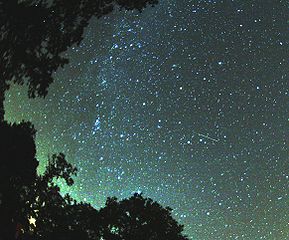There are several meteor showers visible per year. The next on the list is the one known as "the Perseids." Their name comes from the Greek for "the sons of Perseus" because they appear to emanate from the constellation that bears the ancient god-hero's name. The Perseids first appeared (or at least, are first mentioned) in AD 36, and have been a yearly recurrence ever since. They are also known to many Christians (especially Catholics) as the "Tears of St. Lawrence" because they tend to peak on or around his feast day of August 10. And yes, this is the same St. Lawrence who, according to tradition, was grilled alive and when told his suffering could end if he renounced Christ, instead replied, "Turn me over, this side's done." Now that we have the historical curiosities aside, let us get to the real matter of the meteor shower.
The Perseids generally begin in late July (typically the 23rd) but they're not too intense yet. If you sit outside and watch the night sky in late July or early August you'll see some, but not a great amount. This year, their peak is expected to come on the night of August 12 - 13. So on or around that date will be your best bet for viewing, and they will continue to adorn our night sky until August 24th or thereabouts, so if you miss the peak don't fret, you'll still have a chance to see them. But the nights of August 10 - 15 or so will be the best for viewing, with 12 - 13 being the most spectacular.
It is recommended that you rise early (about 3:30 or 4am to beat the sun) and view the shower in the predawn hours, when the earth's rotation scoops more of them up as it rotates toward the sun and thus provides the most awe-inspiring show. But if that is too early for you, there will still be plenty to see in the late evening, when the sun has fully set. For best viewing, you should drive away from city lights, and preferably away from busy roads (as passing car lights will hurt your night vision). State or city parks are a good example of places to go, or open fields. Bring lawn chairs, sleeping bags, blankets, or something else to sit in or recline on (you will not want to lie down completely, best visibility will be if you are looking about half-way at the sky). The more comfortable the better. Dress warmly, since the night air can be chilly, even in summer. Bug spray and water bottles are also recommended. You won't need binoculars, the meteors will catch your eye easily. And if you watch during the peak days, you can see as many as 60-100 meteors per hour or more (record for the Perseids is 173 in one hour, back in 2009). That's all I have for you. Happy hunting and enjoy the show!


No comments:
Post a Comment